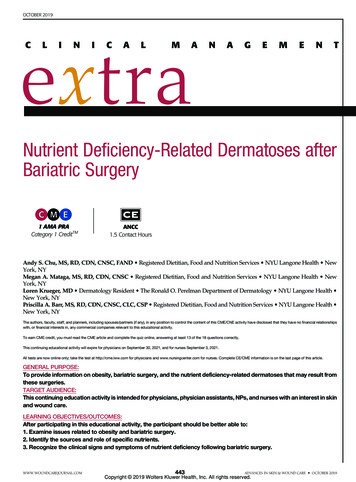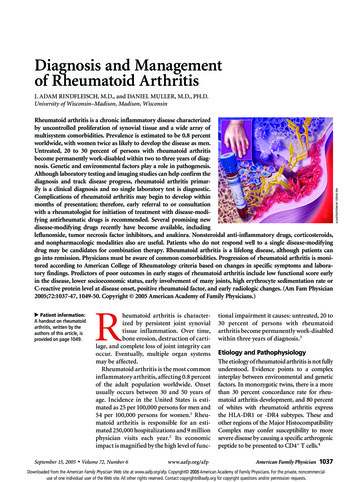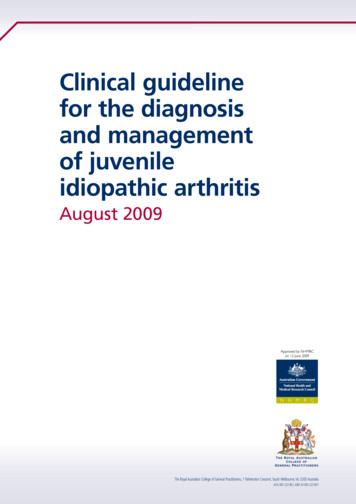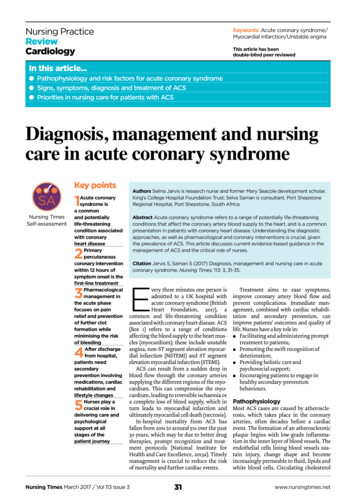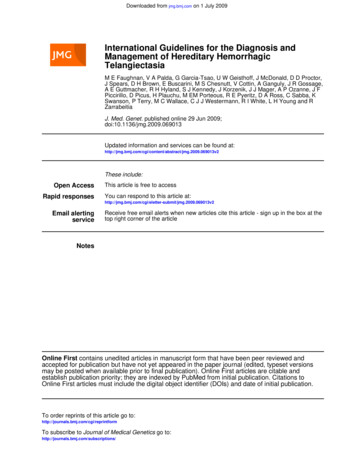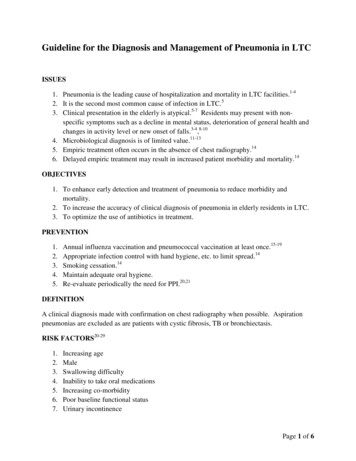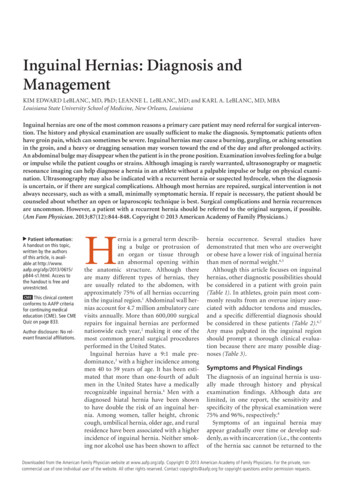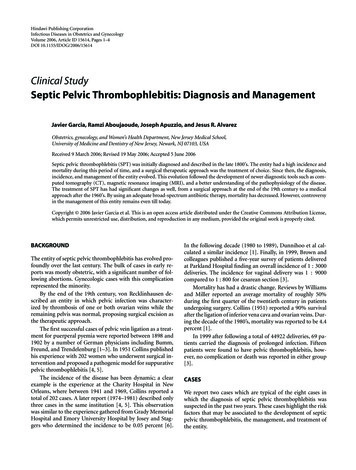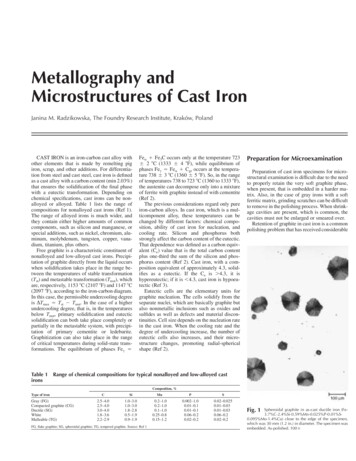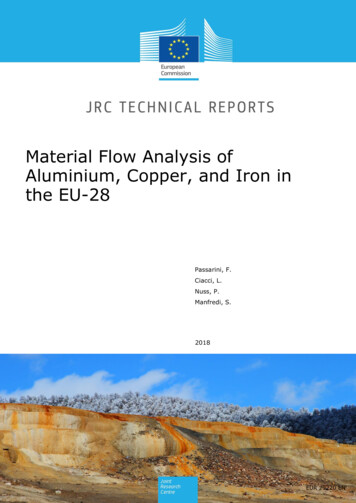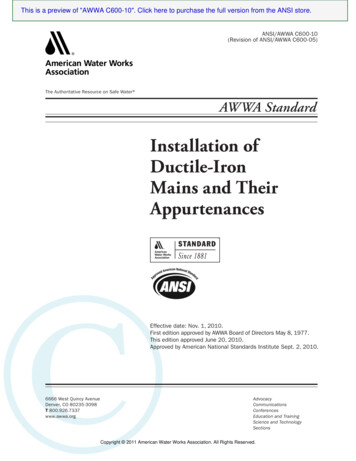
Transcription
Guidelines & Protocols Advisory CommitteeIron Deficiency – Diagnosis and ManagementEffective Date: April 17, 2019ScopeThis guideline provides recommendations for the diagnosis, investigation and management of iron deficiency in patients of all ages.Key Recommendations Use a case-finding approach to identify individuals at risk of iron deficiency and iron deficiency anemia (Table 1). There isno indication for population-based general screening. Determine the cause of iron deficiency. Consider age and clinical presentation when investigating for cause. Iron deficiency by itself causes symptoms for patients, even in the absence of anemia, and warrants investigation andtreatment. Ferritin is the test of choice for the diagnosis of iron deficiency. Ferritin values occur on a continuum. The suggested cut-offs are estimated ranges that should be interpreted using clinicaljudgment based on the patient’s age, gender, risk profile (Table 1) and symptoms. Serum iron, iron binding capacity, and transferrin saturation/fraction saturation are not routinely useful for investigatingiron deficiency anemia. Take a nutrition history and provide dietary education to address dietary risk factors. Caregivers of infants and toddlers should receive guidance to prevent excessive cow’s milk intake. Prescribe oral iron supplements as first line therapy for iron deficiency. One preparation is not preferred over another;patient tolerance should be the guide. Anemia should correct in 2–4 months. Continue oral iron for 4–6 months afteranemia corrects to replenish iron stores. Consider prescribing IV iron when there is inadequate response to oral iron, intolerance to oral iron therapy, or ongoingblood loss.DefinitionsIron deficiency: insufficient total body iron stores, caused by increased requirements, decreased intake, increased loss, and/ordecreased absorption1 (see Table 1).Anemia: low hemoglobin level, most frequently defined as a hemoglobin value over two standard deviations below the genderand age-adjusted mean.1 A hemoglobin value below the local, lab-specific lower reference interval indicates anemia.Iron deficiency anemia (IDA): anemia due to insufficient body iron stores1. The following laboratory findings are typical for IDA:microcytic anemia, hypochromia, and decreased ferritin. IDA may be normocytic if anemia is mild or in early iron deficiency.2
Identification of Patients at Risk for Iron Deficiency and Iron Deficiency AnemiaScreening of the general population for iron deficiency is not recommended.3 Use a case-finding approach to identify patients atrisk of iron deficiency and iron deficiency anemia (Table 1).Common risk profiles, by age, include: Infants and toddlers (refer to page 7) Adolescents and adults: endurance athletes, regular blood donors, disordered eating Pre-menopausal women: especially those with menorrhagia, vegetarian diet All adults age 65 All ages: low socioeconomic status, lack of balanced diet, inadequate nutritional intakeTable 1: Common causes of and risk factors for iron deficiency and IDA in adultsNote: Please refer to Iron Deficiency in Children and Iron Deficiency in Obstetrics on pages 7–8 for causes and risk factors in children,pregnancy and the perinatal period.Increased Requirements Pregnancy (2nd/3rd trimester) Lactation Rapid growth spurts (infants, children, adolescents)Increased Loss Menstruating girls and women (at least 10% are estimatedto have iron deficiency)4 GI bleedingo Colon cancero Gastric/small bowel cancero Hemorrhoidso Peptic ulcer diseaseo Inflammatory bowel diseaseo Angiodysplasiao Esophagitis Regular blood donation Post-operative patients with significant blood loss Hematuria (gross or microscopic) Intravascular hemolysis Endurance athletes2Decreased Intake Low socioeconomic statusVegetarian or vegan dietLack of balanced diet or poor intakeEating disorderAlcohol use disorderAge 65 4Recent immigration from developing regions with lower access toiron-rich foods, higher rates of infectious disease, and higher rates ofmultiparity5, especially Southeast Asia, Africa 6Decreased Absorption Upper GI pathology:o Chronic gastritis (incl. H pylori gastritis, atrophic gastritis/pernicious anemia)o Celiac diseaseo Crohn’s diseaseo Gastric lymphoma Medications that decrease gastric acidity or bind iron, e.g. antacids/PPIs Gastrectomy or duodenal bypass Bariatric surgery Chronic renal failureBCGuidelines.ca: Iron Deficiency – Diagnosis and Management (2019)
Signs and Symptoms in AdultsEven in the absence of anemia, isolated iron deficiency causes symptoms and warrants investigation and treatment. Earlystage iron deficiency can exist without overt anemia, but with other non-hematological symptoms7 due to deficiency of ironcontaining cellular enzymes and unsaturated myoglobin. Some patients may be asymptomatic.Signs and symptoms of iron deficiency and IDA in adults: Fatigue Cold intolerance Headaches Restless leg syndrome* Irritability/depression Nail changes, e.g. koilonychia (spoon nails) Angular cheilitisPica/pagophagia (ice craving)Decreased aerobic work performanceHair lossAdverse pregnancy outcomeImpaired immune functionTestingInitial investigational testsThe recommended initial tests for iron deficiency and for IDA, in otherwise well patients, should usually be limited to serumferritin and complete blood count (CBC). Refer to page 4 for guidance on additional testing in patients with comorbidconditions.Table 2: Initial Investigational TestsInvestigationSerum FerritinApplication Diagnostic test of choice for iron deficiency Adults (ug/L)10, 11 15 diagnostic of iron deficiency15-30 probable iron deficiency 30 iron deficiency unlikely 100 normal iron stores 600 consider test for iron overload12 Children (ug/L) 12 diagnostic of iron deficiency12-20 possible iron deficiencyHematologyProfile (CBC) Hemoglobin value is required to assess severityof anemia May suggest iron deficiency Not diagnostic test of choice for iron deficiencyNotesFerritin values occur on a continuum; cut-offs are suggested and clinicalinterpretation is required: The likelihood of iron deficiency increases with lower ferritinconcentrations, including those that overlap with the normal referenceinterval. The normal reference interval is derived from healthyoutpatients without signs of iron deficiency or chronic illness. In adults, iron deficiency is unlikely if ferritin 30 ug/L (or 70-100 in apatient with chronic inflammatory disease,13 or 50 in the elderly2) Ferritin is an acute phase reactant and may be unreliable in patients withchronic disease, active inflammation, or malignancy. Testing ferritin is notrecommended during acute infection or hospitalization. Non-hematologic symptoms can occur when the serum ferritin is in thelow normal range ( 30 ug/L)The following findings CBC and peripheral smear findings are highlysuggestive of iron deficiency: hypochromia (low mean corpuscular hemoglobin concentration (MCHC)) microcytosis (low mean corpuscular volume (MCV))Patients with microcytic anemia should not be given iron supplementsuntil iron deficiency is confirmed by testing ferritin. Low MCV in the settingof normal ferritin may indicate hemoglobinopathies such as thalassemiaespecially in high risk ethnic groups. Long term iron therapy is harmful forthese patients.Refer to Appendix C: Algorithm for Investigation of Iron Deficiency in Non-Anemic Adults.* Iron therapy may improve restless legs syndrome severity and restlessness. Iron supplementation is recommended if serum ferritin is 75 ug/L.8, 93BCGuidelines.ca: Iron Deficiency – Diagnosis and Management (2019)
Additional tests for the diagnosis of iron deficiency in patients with chronic disease, inflammationor malignancyAnemia of chronic disease (ACD) may co-exist with an element of true iron deficiency. However, ferritin values may be falselyelevated in chronic disease as ferritin is an acute phase reactant. In this specific situation, ordering a fasting serum iron andtransferrin saturation may be helpful to diagnose iron deficiency that may be missed by solely relying on ferritin. A typical irondeficiency profile for such patients (e.g. those with inflammatory bowel disease) is: low serum iron, low or normal transferrin (i.e. total iron binding capacity), and fasting transferrin saturation below 20%.The clinical approach for such patients is the same as for iron deficiency in otherwise well patients (investigate for cause,supplement with iron and refer as appropriate). Patients with a true iron deficiency which co-exists with anemia of chronicdisease will respond to a diagnostic trial of iron supplementation.Guidance for the investigation and management of iron deficiency in the setting of specific chronic diseases is provided: Chronic Kidney Disease (CKD): Kidney Disease: Improving Global Outcomes (KDIGO) guidelines14 recommend includingCBC, absolute reticulocyte count, serum ferritin and TSAT as well as other tests (vitamin B12) in the initial evaluation of anemiain patients with CKD and anemia. Note that ferritin levels in patients with CKD may be elevated due to inflammation, and somany not accurately reflect iron status and need for supplementation. TSAT 24% is the current recommended threshold toconfirm iron deficiency. In patients with CKD, if iron deficiency and other nutritional deficiencies are rectified, and anemiapersists, consider erythropoiesis stimulating agents, which would require specialist referral. Heart Failure: Canadian Cardiovascular Society guidelines15 recommend consideration of IV iron therapy for heart failurepatients with all of the following: ejection fraction 40%, serum ferritin 100 mg/L or between 100–299 mg/L, andTSAT 20%.If ferritin is unexpectedly elevated, in a patient without chronic disease, active inflammation, or malignancy, C-reactive protein(CRP) can help support the diagnosis of an inflammatory process. Refer to the BC Guideline: C-Reactive Protein and ErythrocyteSedimentation Rate Testing for information on the use of CRP.Investigation of the Etiology of Iron DeficiencyOnce iron deficiency/IDA is diagnosed, the etiology must be identified. Clinical evaluation of the cause of iron deficiency isimportant. It should be based upon a directed history, symptom review and physical examination.Directed history should include: nutrition and physical activity history pregnancy status and number of pregnancies history of blood loss, including GI bleeding, hematuria, menorrhagia, and blood donation GI symptoms including changes in bowel habits, abdominal pain, dyspepsia, and unexplained weight loss family history including colorectal cancer16Menorrhagia is the most frequent cause of iron deficiency among pre-menopausal women. Consider referral to gynecologist formanagement of heavy menses and/or consider bleeding disorder, e.g. von Willebrand disease screening.Testing for malabsorption is recommended if small bowel disease is clinically suspected, or if oral iron supplementation results ininadequate response despite compliance.Iron deficiency/IDA in adult men and post-menopausal women and in pre-menopausal women without menorrhagia is morelikely to have a serious underlying cause of blood loss including malignancy.16 Consider upper/lower endoscopy.4BCGuidelines.ca: Iron Deficiency – Diagnosis and Management (2019)
Investigation of overt and occult GI and GU bleedingPrimary care providers are encouraged to consult with colleagues including local gastroenterology services or the RACE line toobtain rapid advice and avoid unnecessary travel and wait times.FIT and FOBT TestingFIT and FOBT testing are not indicated for investigation of overt GI bleeding and are not needed for patients being referred.Given the risk of false negatives, FIT and FOBT testing should not be used to rule out GI bleeding.Overt GI bleedingOvert GI bleeding that is otherwise unexplained, new, or out of pattern requires GI evaluation. Consider referral for GIevaluation.BC colon cancer screening guidelines recommend that patients with signs or symptoms of colon cancer (e.g. unexplained GIbleeding, unexplained iron deficiency anemia) proceed directly to specialist referral for possible endoscopic investigation.17, 18If any doubt remains about whether to refer for GI investigations, referral is strongly encouraged due to the potentially severeconsequences of delayed identification of colorectal cancer. Age-specific risk for colon and rectal cancer is elevated amongthose born circa 1990 compared to older cohorts.19Overt GU bleedingConsider referral to urologist for further work-up, especially for gross painless hematuria.Unexplained iron deficiency/IDAAdult males, post-menopausal females and pre-menopausal females with unexplained iron deficiency/IDA should receive: referral for GI investigations (upper/lower endoscopy) screening for GU bleeding with urinalysis screening for celiac diseaseManagementThe objective of treatment is to replenish iron stores: normalize hemoglobin levels and ferritin.16 Target normal ferritin 100 µg/L.Iron replacement therapy should begin as soon as iron deficiency is detected, whether or not anemia is also present.The exception is: patients with microcytic anemia should not be given iron supplements until iron deficiency is confirmed bytesting ferritin. Low MCV in the setting of normal ferritin may indicate hemoglobinopathies such as thalassemia. Long term irontherapy is harmful for these patients.Individualize disease-specific management depending on underlying cause.20 Even when there is an apparently obvious causethe etiology may be multifactorial.Dietary iron intakeTo help prevent iron deficiency, encourage all individuals to consume a diet with sufficient iron. This may include establishingindividualized iron intake goals according to recommended daily intake based on sex, age, pregnancy status, and diet. Referto Associated Documents for recommended daily int
Iron Deficiency – Diagnosis and Management Effective Date: April 17, 2019 Scope This guideline provides recommendations for the diagnosis, investigation and management of iron deficiency in patients of all ages. Key Recommendations Use a case-finding approach to identify individuals at risk of iron deficiency and iron deficiency anemia (Table 1). There is

